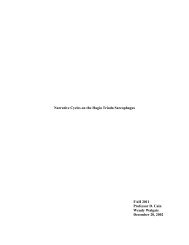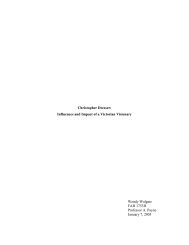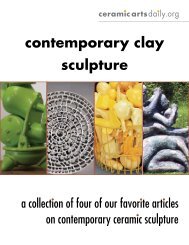You also want an ePaper? Increase the reach of your titles
YUMPU automatically turns print PDFs into web optimized ePapers that Google loves.
make disappear. I've spent this time at Cranbrook finding out what glazes work with<br />
other glazes, colour combinations that pop out, and flow together. Along with constant<br />
glaze testing, I have tried to observe how colour influences form. Through a non-chalant<br />
and fearless approach in the application of colour, I now have a hefty palette of colours to<br />
continue to work with.<br />
Glaze testing cannot really ever stop; there is always room for changes, whether it's more<br />
matte surfaces or a different range of hues. The application of colour and the selfeducation<br />
of how it all works together, can only be learned by doing it. Just jump in and<br />
put on that colour. Take it out of the kiln and look at it for a while, throw some more<br />
colour on it and fire it again and again.<br />
When I am preparing to glaze, I use a permanent felt pen to write on the different areas of<br />
the piece as I visualize what colours to put where. This method helps me remember<br />
where I've placed the different colours, since they all look the same in the application<br />
stage. You can also write on top of dry glazes with a permanent pen, to keep things<br />
straight.<br />
Betty Woodman, American Ceramics 7/3, 1989 (pg. 23):<br />
I am interested in how colour changes our reading of an image<br />
and changes as we move around an image. I use colour to enrich,<br />
to counteract, to get the viewer to examine the form.<br />
Kandinsky: Complete Writings on Art, edited by Kenneth C.<br />
Lindsay (pg. 377):<br />
Art in many respects resembles religion. Its development consists<br />
not of new discoveries that obliterate old truths and stamp them as<br />
false (as is apparently the case in science). Its development<br />
consists in moments of sudden illumination, resembling a flash of<br />
lightning, of explosions that burst in the sky like fireworks,<br />
scattering a whole "bouquet" of different - coloured stars around<br />
them. This illumination reveals with blinding clarity new<br />
perspectives, new truths that are in essence nothing other than the<br />
organic development, the continuing organic growth of earlier<br />
wisdom, which is not cancelled out by the latter, but remains living<br />
and productive as truth and as wisdom. The new branch does not<br />
render the tree trunk superfluous: the trunk determines the<br />
possibility of the branch.<br />
Hundertwasser, Harry Rand (pg. 130):<br />
14





